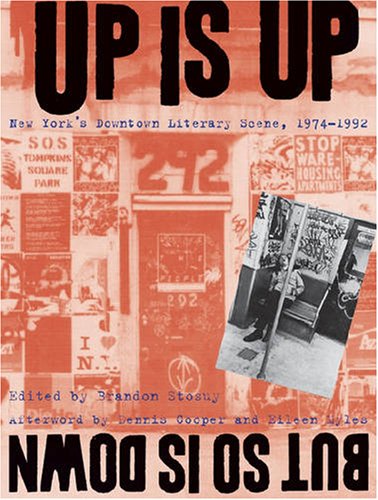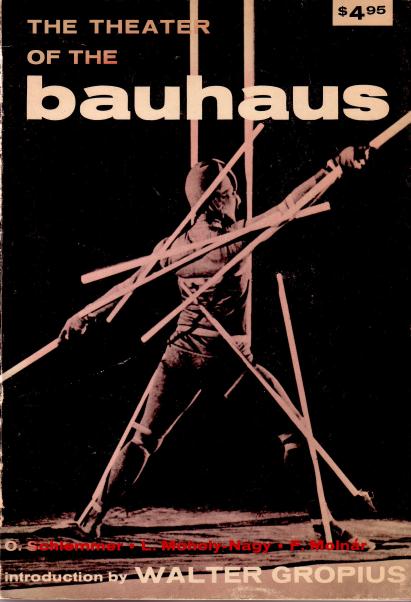Brandon Stosuy (ed.): Up Is Up, But So Is Down: New York’s Downtown Literary Scene, 1974-1992 (2006)
Filed under book | Tags: · 1970s, 1980s, 1990s, art, diy, history of literature, literature, music, new york, poetry, publishing, theatre

“Sometime after Andy Warhol’s heyday but before Soho became a tourist trap, a group of poets, punk rockers, guerilla journalists, graffiti artists, writers, and activists transformed lower Manhattan into an artistic scene so diverse it became known simply as “Downtown.“ Willfully unpolished and subversively intelligent, figures such as Spalding Gray, Kathy Acker, Richard Hell, David Wojnarowicz, Lynne Tillman, Miguel Piñero, and Eric Bogosian broke free from mainstream publishing to produce a flood of fiction, poetry, experimental theater, art, and music that breathed the life of the street.
The first book to capture the spontaneity of the Downtown literary scene, Up Is Up, But So Is Down collects more than 125 images and over 80 texts that encompass the most vital work produced between 1974 and 1992. Reflecting the unconventional genres that marked this period, the book includes flyers, zines, newsprint weeklies, book covers, and photographs of people and the city, many of them here made available to readers outside the scene for the first time. The book’s striking and quirky design—complete with 2-color interior—brings each of these unique documents and images to life.
Brandon Stosuy arranges this hugely varied material chronologically to illustrate the dynamic views at play. He takes us from poetry readings in Alphabet City to happenings at Darinka, a Lower East Side apartment and performance space, to the St. Mark’s Bookshop, unofficial crossroads of the counterculture, where home-printed copies of the latest zines were sold in Ziploc bags. Often attacking the bourgeois irony epitomized by the New Yorker’s short fiction, Downtown writers played ebulliently with form and content, sex and language, producing work that depicted the underbelly of real life.
With an afterword by Downtown icons Dennis Cooper and Eileen Myles, Up Is Up, But So Is Down gathers almost twenty years of New York City’s smartest and most explosive—as well as hard to find—writing, providing an indispensable archive of one of the most exciting artistic scenes in U.S. history.”
With an afterword by Dennis Cooper and Eileen Myles
Publisher NYU Press, 2006
ISBN 9780814740118
500 pages
Downtown Collection at NYU’s Fales Library
Reviews: Ed Halter (Village Voice, 2006), Meghan O’Rourke (New York Times, 2006), Tim W. Brown (Columbia Journal of American Studies, n.d).
Commentary: Cynthia Carr (New York Times, 2006), Peter Cherches (2006).
PDF (39 MB, updated on 2019-8-23)
Comments (2)Walter Gropius (ed.): The Theater of the Bauhaus (1925–) [DE, EN]
Filed under book | Tags: · acrobatics, art history, avant-garde, bauhaus, circus, constructivism, dance, pantomime, theatre

“The Bauhaus movement was one of this century’s most daring experiments in arts education, and its influence on architecture, design, and the visual arts is well known. Many of its most important ideas are revealed in Bauhaus writings about theatrical performance and performance spaces. Originally published in Germany in 1925 — at the height of the Bauhaus movement’s influence– The Theater of the Bauhaus collects writings from some of the movement’s most important figures and describes a theater stripped of history, moralism, scenery, and, for that matter, narrative itself. The Bauhaus group believed traditional theater to be little more than a vehicle for propaganda, with its “peep show stage” separating spectators from performers. They rejected as well the theater of ridicule and satire practiced by the Dadaists and Expressionists. In place of both traditional drama and the avant-garde that lampooned it, Oskar Schlemmer and his Bauhaus associates created an abstract theater of movement, color, light, form, and sound-language would be added later, once the stage had been purged of its “literary encumbrance.” They believed that humanity’s essential nature–freed from history, tradition, class, and nationality–would find expression in theatrical works that incorporated pantomime, masks, dance, and acrobatics.”
Contents: Walter Gropius: Introduction; Oskar Schlemmer: Man and Art Figure; Laszlo Moholy-Nagy: Theater, Circus, Variety; Farkas Molnar: U-Theater; Oskar Schlemmer: Theater (Bühne); Translator’s Note.
Publisher Albert Langen, Munich, 1925
Volume 4 of Bauhausbücher series
84 pages
via Bibliothèque Kandinsky
English edition
Translated by Arthur S. Wensinger
Publisher Wesleyan University Press, 1961
ISBN 0819560200
110 pages
Die Bühne im Bauhaus (German, 72 MB, via Bibliothèque Kandinsky, added on 2014-8-17, updated on 2022-4-13)
Die Bühne im Bauhaus (German, PDF, JPG, in Heidelberg U Library, added on 2019-7-7)
The Theater of the Bauhaus (English, trans. Arthur S. Wensinger, 1961, 6 MB, updated on 2016-10-15)
See also other titles in Bauhaus Books series.
Comments (5)Iliazd: Lidantiu faram (1923) [Russian]
Filed under artist publishing, play | Tags: · dada, futurism, poetry, typography, visual poetry, zaum

Lidantiu faram [Le-Dantyu as a Beacon] is a play typed in zaum language by the Georgian-French artist-typographer Iliazd (Ilya Zdanevich). It remains an unsurpassed example of visually fascinating typographical contrivances and was to exert a decisive influence on the typographical component of international dadaist poetry.
“The book is preceded by a table of symbols which indicate how the sounds they stand for, such as a click of the tongue, are to be pronounced. The stressed symbol is given a capital letter, often large and bold, in the middle of the word, while unstressed vowels are written as pronounced, not necessarily as normally spelt.
The plot, in a parodic inversion of Gogol’s short story ‘The Portrait’, investigates the nature of reality in its relation to art. It begins with the Spirit [Zaperedukhyai] muttering a soliloquy over the body of a dead woman. The Spirit’s words do not contain vowels, an omission suggesting firmness. The villain of the piece, the realist painter [peredvizhnik] who is presented as a lisping phoney, paints a lifelike portrait of the dead woman. Then comes an obscure avant-garde artist, Mikhail Ledentu, who represents genuine liberated art and he paints an unlike portrait of the same lady. Both portraits come alive during the play, with Unlike killing Lifelike. The Spirit also dies but the forces of life are resurrected. The play ends with an ensemble superimposed on each other: the harmonious trio of the living is echoed by the dissonant octet of the dead. The forces of death include a Greek chorus of five ugly realism-loving women, usually singing in quintet. They are defined as truperdy (this combines death and decay with scatology) and their individual names are mostly rare Russian folk words with sexual anatomical meanings. The quintets show strong individualisation of each part: one of them speaks in vowels only; another hissing and lisping; another in abrupt and primitive tones adding clicks of her tongue to her words; the other two speak in a coarse and unpleasant idiom.
Le-Dantyu as a Beacon is an astonishing tour-de-force. Every page number, for instance, is created in a different and inventive manner (and there are sixty-one of them), and the variety of typeforms used must surely have entailed ransacking the typecases of several printers.” (from Alan Bartram’s Futurist Typography and the Liberated Text, 2005, altered)
Lidantiu faram (Лидантю фарам; Ledentu le Phare: poème dramatique en zaoum)
Preface by Georges Ribemont-Dessaignes, in French (attached at the end)
Cover by N. Granowsky
Typography by Ilya Zdanevich
Publisher Éditions du 41º, Paris, 1923
61 pages + 8-page prospectus
Commentary: Lewis Blackwell (20th-century Type, 2004: 35), Alan Bartram (Futurist Typography, 2005: 50-69).
PDF (15 MB, via Iowa Digital Library)
PDF (107 MB, added on 2020-12-5, via Kunsthaus Zurich)

